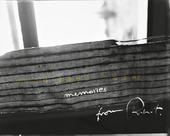
|
Robert Frank: Good Days Quiet
Hardback
Main Details
| Title |
Robert Frank: Good Days Quiet
|
| Authors and Contributors |
By (author) Robert Frank
|
| Physical Properties |
|
| Category/Genre | Individual photographers |
|---|
| ISBN/Barcode |
9783958295506
|
| Classifications | Dewey:779.092 |
|---|
| Audience | |
|---|
|
Publishing Details |
| Publisher |
Steidl Publishers
|
| Imprint |
Steidl Verlag
|
| Publication Date |
23 May 2019 |
| Publication Country |
Germany
|
Description
In this, Robert Frank's newest book, he both acknowledges and moves beyond his acclaimed visual diaries (2010-17), which juxtapose iconic photos from throughout his career with the more personal pictures he makes today and suggestive, often autobiographical text fragments. In Good Days Quiet Frank's focus is life inside and outside his beloved weather-beaten wooden house in Mabou, where he has spent summers for decades with his wife June Leaf. Among portraits of Leaf, Allen Ginsberg and Frank's son, are images of the house's simple interior with its wood-fuelled iron stove, humble furniture and bare light bulbs, as well as views of the land and sea by the house: snow-covered, windswept, stormy or lit by the dying sun. Frank's Polaroids scanned for the book show various deliberate states of deterioration and manipulation at his hands, including texts that move from the merely descriptive ("watching the crows") to the emotive ("memories," "grey sea-old house / can you hear the music"). As always in Frank's books, his message lies primarily in the photos' lyrical sequence, an influential approach to the photobook pioneered by and today well at home in his 93-year-old hands. Time and tide wait for no man. Rober t Frank
Author Biography
Robert Frank was born in Zurich in 1924 and immigrated to the United States in 1947. He is best known for his seminal book The Americans, first published in English in 1959, which gave rise to a distinctly new form of the photobook, and his experimental film Pull My Daisy(1959). Frank's other important projects include the books Black White and Things (1954), The Lines of My Hand (1972) and the film Cocksucker Blues for the Rolling Stones (1972). He divides his time between New York City and Nova Scotia, Canada.
ReviewsGood days Quiet appears more personal and open - it reads like a diary without narrative and unfolds as a series of impressions, loosely arranged and deeply felt.--Sabrina Mandanici "Collector Daily"
|